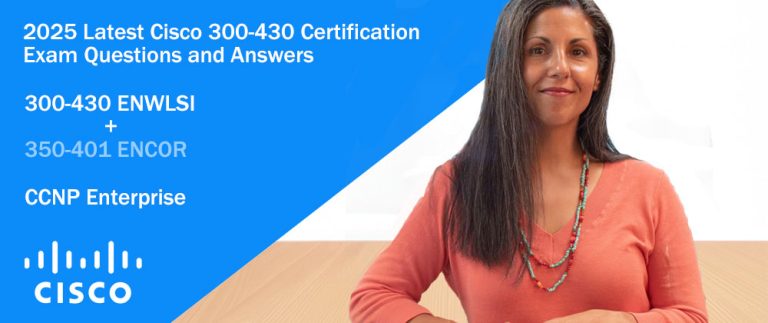QUESTION 1
NetFlow provides valuable information about network users and applications, peak usage times, and traffic routing. Which function is of NetFlow?
A. monitor configuration changes
B. monitor CPU utilization
C. monitor link utilization
D. generate traps for failure conditions
Correct Answer: C
QUESTION 2
The P4S company is deploying OSPF on a point-to-multipoint Frame Relay network. The remote sites needn??t to communicate with each other and there are a relatively small number of sites (scaling is not a concern). How to configure OSPF for this topology in order to minimize the additional routing information injected into the network and keep the configuration size and complexity to a minimum?
A. Configure the link as OSPF nonbroadcast and manually configure each of the remote sites as a neighbor.
B. Configure the link as OSPF broadcast and configure the hub router to always be the designated router.
C. Configure the link as OSPF broadcast and configure a mesh group towards the remote routers.
D. Configure the link at the hub router as OSPF point-to-multipoint and at the remote routers as OSPF point-to-point.
Correct Answer: B
QUESTION 3
What is high availability?
A. redundant infrastructure
B. clustering of computer systems
C. reduced MTBF
D. continuous operation of computing systems
Correct Answer: D
QUESTION 4
What is the way that an OSPF ABR uses to prevent summary route information from being readvertised from an area into the network core (Area 0)?
A. It advertises only inter-area summaries to the backbone.
B. It uses poison reverse and split horizon.
C. It only sends locally originated summaries to the backbone.
D. It compares the area number on the summary LSA to the local area.
Correct Answer: C
QUESTION 5
Connecting an IS-IS router to four links and redistributing 75 routes from RIP. How many LSPs will be originated by this router?
A. one LSP: containing the router information, internal routes, and external routes
B. six LSPs: one for each link, one containing router information, and one containing external routing information C. two LSPs: one containing router information and internal routes and one containing external routes
D. three LSPs: one containing all links, one containing router information, and one containing external routing information
Correct Answer: A
QUESTION 6
According to the network in this exhibit, traffic directed towards 10.1.5.1 arrives at P4S-R4. Which path will the traffic take from here?
A. It will take P4S-R2.
B. It will not take any path. P4S-R4 will drop the traffic.
C. It will take P4S-R3.
D. It will load share between P4S-R2 and P4S-R3.
Correct Answer: A
QUESTION 7
You are the Cisco Network Designer in P4S. Which two characteristics are most typical of a SAN? (Choose two.)
A. NICs are used for network connectivity.
B. Servers request specific blocks of data.
C. Storage devices are directly connected to servers.
D. A fabric is used as the hardware for connecting servers to storage devices.
Correct Answer: BD
QUESTION 8
In the network presented in the following exhibit, all routers are configured to perform EIGRP on all interfaces. All interface bandwidths are set to 1000, and the delays are configured as displayed. In the topology table at Router P4S-RC, you see only one path towards 10.1.1.0/24. Why Router P4S-RC only has one path in its topology table?
A. Router P4S-RB is not advertising 10.1.1.0/24 to Router P4S-RC due to split horizon.
B. Router P4S-RD is not advertising 10.1.1.0/24 to Router P4S-RC because Router P4S-RC is its feasible successor.
C. Router P4S-RD is not advertising 10.1.1.0/24 to Router P4S-RC due to split horizon.
D. Router P4S-RB is not advertising 10.1.1.0/24 to Router P4S-RC because Router P4S-RC is its feasible successor.
Correct Answer: C
QUESTION 9
How many broadcast segments are contained in this network according to the exhibit?
B. 2
C. 4
D. 5
Correct Answer: B QUESTION 10
Which VPN management feature would be considered to ensure that the network had the least disruption of service when making topology changes?
A. dynamic reconfiguration
B. path MTU discovery
C. auto setup
D. remote management
Correct Answer: A QUESTION 11
What information can you get from TCP flags while assessing an attack?
A. source of the attack
B. type of attack
C. target of the attack
D. priority of the attack traffic
Correct Answer: B QUESTION 12
Which two steps can be taken by the sinkhole technique? (Choose two.)
A. reverse the direction of an attack
B. redirect an attack away from its target
C. monitor attack noise, scans, and other activity
D. delay an attack from reaching its target
Correct Answer: BC QUESTION



